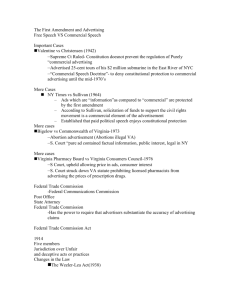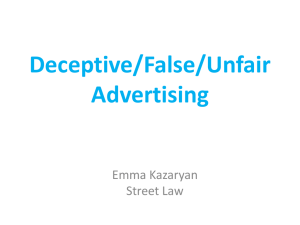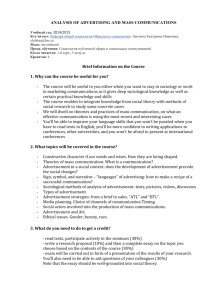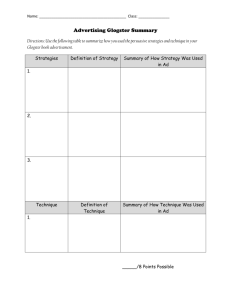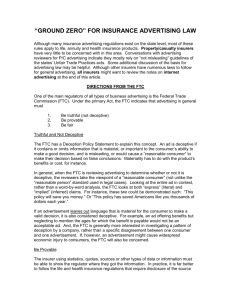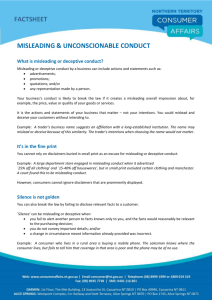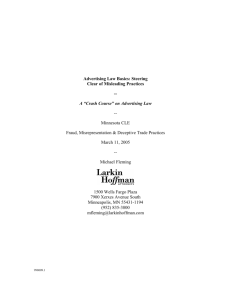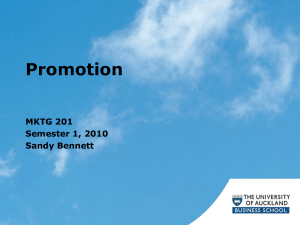SUBSTANTIATING ADVERTISING CLAIMS:
advertisement
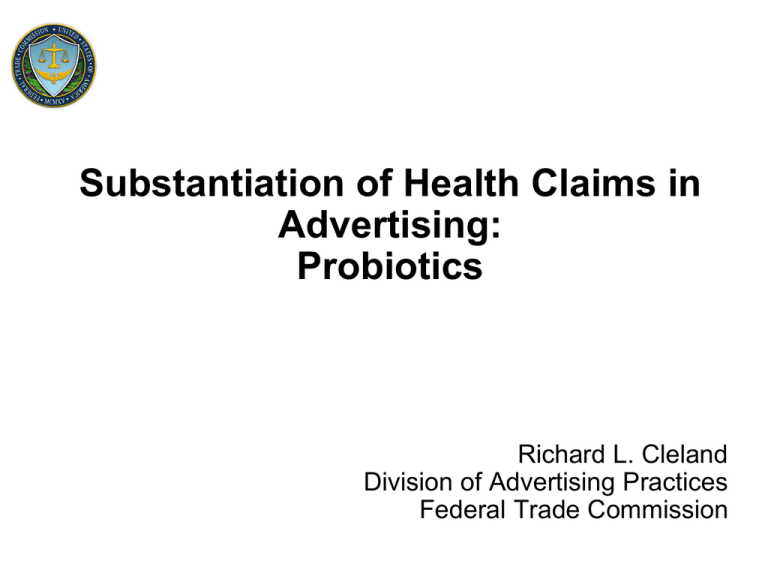
Substantiation of Health Claims in Advertising: Probiotics Richard L. Cleland Division of Advertising Practices Federal Trade Commission Disclaimer My comments reflect my own views and do not necessarily reflect the views of the Commission or any individual Commissioner. Regulatory Framework • Section 5 of the FTC Act prohibits “unfair or deceptive acts or practices in or affecting commerce.” • Section 12 of the FTC Act prohibits disseminating or causing the dissemination of a false advertisement in commerce for the purpose of inducing, or that is likely to induce, the purchase of any food, drug, device, service, or cosmetics. Deceptive and Misleading Advertising • An advertisement is deceptive if it contains a representation or omission of fact that is likely to mislead a consumer acting reasonably under the circumstances, and that representation is material to a consumer’s purchasing decision. – False claims – Failure to disclose material facts – Unsubstantiated claims Ad Meaning • Ads are interpreted from the perspective of a reasonable consumer in the target audience. • Ads may have more than one reasonable interpretation. • Where an ad conveys more than one meaning, only one of which is misleading, a seller is liable for the misleading interpretation even if nonmisleading interpretations are possible. • An ad is misleading if a significant minority of reasonable consumers are likely to take away the misleading claim. Evidence of Ad Meaning • The primary evidence of what representations an advertisement conveys is the advertisement itself. • Express claims directly state the representation at issue and the representation itself establishes the meaning of the ad claim. • In determining what claim or claims an ad communicates to reasonable consumers, it is necessary to look “at the interaction between and among the constituent elements of the ad to determine the ‘net impression’ that is conveyed by the ad as a whole.” • The Commission may rely on the ad itself and need not resort to extrinsic evidence if the text or depictions are clear enough that the Commission can “conclude with confidence” that the claim is conveyed to reasonable consumers. • Extrinsic evidence can “include common usage of terms, expert opinion as to how an advertisement might reasonable by interpreted, copy tests, generally accepted principles of consumer behavior, surveys, or ‘any other reliable evidence of consumer interpretation.’” Nestlé Healthcare Nutrition Probiotic straw and drink for children Ad Claims: prevention of upper respiratory infections; protects against cold & flu; reduces school absences; reduces duration of acute diarrhea in children Some good evidence but claims went beyond science In the Matter of Nestlé Healthcare Nutrition, Inc., FTC File No. 092 3087 (proposed consent 2010) Advertisers must have substantiation for objective product claims • Making objective claims without a reasonable basis is a deceptive practice. • Advertising claims made for a food, dietary supplement, drug, cosmetic or service without a reasonable basis constitute false advertising. Level of Substantiation • Where an advertisement represents, either expressly or by implication, that the claim is supported by a certain amount or level of substantiation, the advertiser must possess, prior to dissemination of the advertisement, at least that level of support for the claim. Determining the Reasonable Basis • Relevant factors include: – the type of claim (health or safety claim?) – the product (experience or credence claim?) – the consequences of a false claim – the benefits of a truthful claim – the cost of developing substantiation for the claim – the amount of substantiation experts in the field believe is reasonable Health-related Claims • Generally, health-related claims must be substantiated by competent and reliable scientific evidence. • Competent and reliable scientific evidence is evidence that is sufficient to satisfy the relevant scientific community that the claim is true. Health Claims: Competent and Reliable Scientific Evidence • Evidence, consisting of tests, analyses, research, or studies that have been conducted and evaluated in an objective manner by qualified persons and are generally accepted in the profession to yield accurate and reliable results, that is sufficient in quality and quantity based on standards generally accepted in the relevant scientific fields, when considered in light of the entire body of relevant and reliable scientific evidence, to substantiate that the representation is true. Therapeutic Claims • One or more clinical trials – – – – – – – – – Placebo controlled Double blind Randomized Product vs. ingredient testing Independently conducted (two studies) Valid statistical analysis (between group) Relevant endpoint Sufficient data for evaluation Conducted by qualified persons It May Not Be the Study! • • • • • • • Different product? Different ingredients? Different dosage? Different form of administration? Different directions of use? Was the sample representative of the target population? Was the study population significantly different than the target audience for the advertising? • Does the study have the right endpoints to support the advertising claims? • Do the results matter? Flawed and Inapposite Scientific Evidence • Failure to distinguish between prevention and treatment; • Relying on unvalidated biomarkers, e.g., cellular effects on the immune system (natural killer cells or t-lymphocytes); • Relying on supplementation studies when products were not promoted for daily use; • Relying on studies using different methods of administration; • No statistical analysis and data not available; • Failing to identify inclusion criteria; • Relying on non-representative circumstances (ultra-marathon runners); • Relying on studies not adequately blinded; and • Used unvalidated symptom scales.


